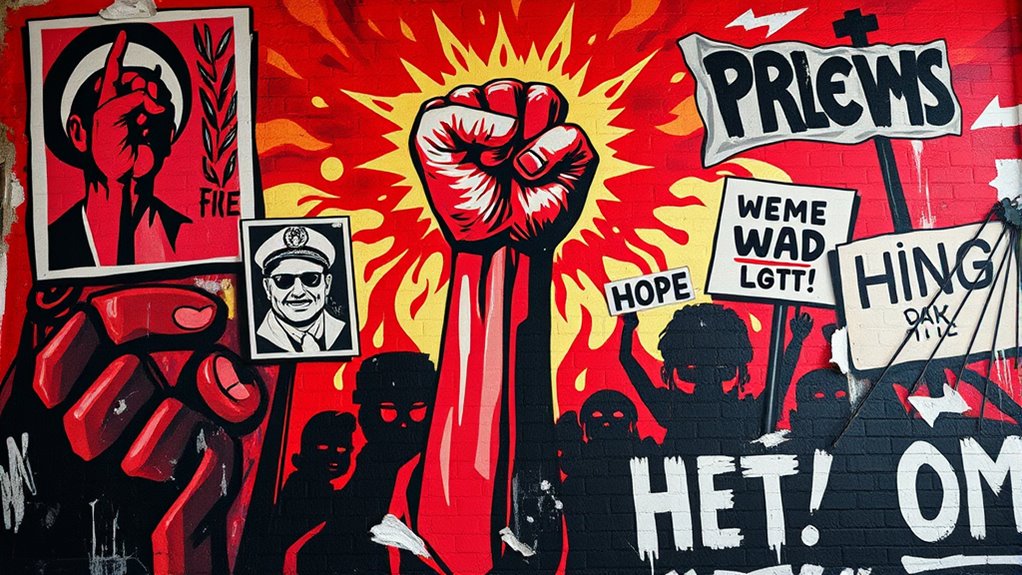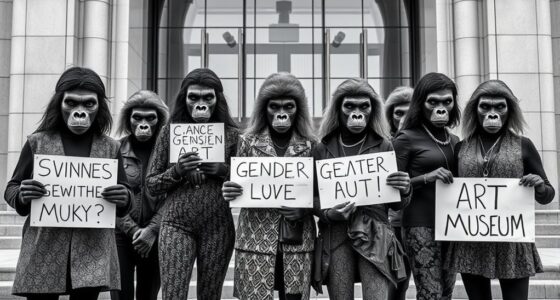Protest art has been a crucial tool for challenging authority and inspiring change, evolving from revolutionary posters and murals during the French Revolution to today’s digital multimedia expressions. Throughout history, it uses powerful symbols, bold imagery, and satire to communicate messages that resist censorship and amplify voices of the marginalized. Its impact persists in transforming public spaces into platforms for dissent and hope. If you want to explore how protest art continues to shape history and activism, there’s much more to uncover.
Key Takeaways
- Protest art has evolved from revolutionary posters and murals during the French Revolution to contemporary digital and multimedia activism.
- Symbols, allegories, and satire have long been used to embed layered political messages across different eras.
- Censorship efforts historically suppressed protest artwork, often fueling acts of resistance and adaptation by artists.
- Iconic protest artworks have shaped social movements, transforming public spaces into platforms for dissent and dialogue.
- Modern technology enables rapid global dissemination of protest art, amplifying marginalized voices and social change worldwide.

Have you ever wondered how art has fueled social change throughout history? Throughout the ages, protest art has served as a powerful tool for challenging authority, raising awareness, and inspiring action. It’s not just about creating visually striking pieces; it’s about embedding messages that resonate deeply with viewers, often through political symbolism. When artists harness symbols—such as flags, icons, or allegorical images—they tap into collective memories and shared beliefs, making their messages instantly recognizable and emotionally compelling. This symbolic language becomes a form of resistance, especially when political regimes attempt to silence dissent through artistic censorship. Authorities often see protest art as a threat, leading to suppression, destruction, or manipulation of artworks to fit official narratives. By doing so, they try to stifle voices of opposition, but often, this censorship only fuels the fire of protest, turning artworks into symbols of defiance.
In the face of artistic censorship, protest artists have found ways to circumvent restrictions or use subversive imagery to communicate their messages. For example, during oppressive regimes, artists might hide their political symbolism within seemingly innocuous images or employ satire to critique authorities covertly. This clever use of visual language allows their messages to survive despite attempts to erase or distort them. Over time, protest art has evolved from simple graffiti or posters into sophisticated forms such as murals, installations, and multimedia projects, all rooted in the desire to challenge social injustices. These works often carry layered meanings, making them accessible yet complex, engaging viewers to interpret their political symbolism. Additionally, the development of digital and multimedia platforms has expanded the reach and impact of protest art, allowing messages to circulate rapidly and globally.
You might notice that many iconic protest artworks originate from moments of intense social upheaval—like the French Revolution or civil rights movements—where artists used their craft to communicate resistance and hope. Whether it’s a revolutionary poster, a painted mural, or a provocative sculpture, these pieces stand as testaments to art’s role in shaping history. Despite attempts at artistic censorship, protest art persists, often becoming more daring and influential precisely because of its opposition to suppression. It transforms public spaces into platforms for dialogue and dissent, ensuring that the messages of marginalized voices reach wider audiences. In this ongoing battle between expression and repression, protest art continues to serve as a crucial voice for change, reminding us that even in the face of censorship, creative resistance can thrive and inspire collective action.
Frequently Asked Questions
How Has Technology Influenced Protest Art’s Evolution?
Technology has transformed protest art by enabling digital activism and incorporating augmented reality, making messages more immersive and accessible. You can now share your activism instantly online, reaching a global audience. Augmented reality allows you to create interactive experiences that deepen engagement. You’re empowered to innovate your protest art, making it more dynamic and impactful, fostering greater awareness and participation in social movements worldwide.
What Are the Most Iconic Protest Artworks Globally?
You should know that iconic protest artworks like Picasso’s Guernica and Banksy’s street art have a powerful historical impact, shaping cultural expression worldwide. These pieces capture social struggles, inspiring change and raising awareness. Their bold visuals transcend language barriers, making a lasting statement. You can see how they influence movements, showing that protest art remains a essential tool for voicing dissent and shaping history’s course.
How Do Governments Typically Respond to Protest Art?
Governments often respond to protest art with censorship and artistic repression. They may remove or block artworks they find threatening, arrest or intimidate artists, and enforce strict regulations to limit political expression. This approach aims to suppress dissent, but it can also highlight the power of protest art to challenge authority and inspire change. Your awareness of these responses helps you understand the ongoing struggle between artistic freedom and governmental control.
Can Protest Art Be Considered a Form of Vandalism?
You might see protest art as vandalism, but it often blurs with artistic expression within legal boundaries. While some pieces damage property, many aim to challenge societal norms or highlight issues without crossing legal lines. The key is intent and context. If your protest art sparks dialogue without destruction, it’s more about activism than vandalism, emphasizing free expression rather than illegal damage.
What Role Does Social Media Play in Modern Protest Art?
You see social media’s role in modern protest art through digital activism and viral campaigns. For example, a viral hashtag or meme can spark awareness and mobilize supporters quickly. Social media amplifies voices, making protest art more accessible and immediate. It allows you to share powerful visuals and messages globally, turning individual acts into collective movements, and transforming traditional protest art into a dynamic tool for change.
Conclusion
So, next time you see a rebellious mural or a cheeky billboard, remember—protest art has long been a powerful voice for change, even if it’s often ignored or misunderstood. Ironically, what’s meant to wake us up can sometimes fade into background noise. But its impact lingers, reminding you that art isn’t just for beauty; it’s for revolution. After all, the loudest messages often come from the quietest, most unexpected places.









